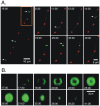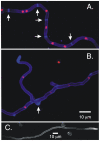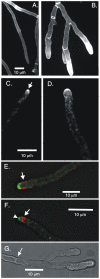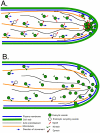The functions of myosin II and myosin V homologs in tip growth and septation in Aspergillus nidulans
- PMID: 22359575
- PMCID: PMC3281053
- DOI: 10.1371/journal.pone.0031218
The functions of myosin II and myosin V homologs in tip growth and septation in Aspergillus nidulans
Abstract
Because of the industrial and medical importance of members of the fungal genus Aspergillus, there is considerable interest in the functions of cytoskeletal components in growth and secretion in these organisms. We have analyzed the genome of Aspergillus nidulans and found that there are two previously unstudied myosin genes, a myosin II homolog, myoB (product = MyoB) and a myosin V homolog, myoE (product = MyoE). Deletions of either cause significant growth defects. MyoB localizes in strings that coalesce into contractile rings at forming septa. It is critical for septation and normal deposition of chitin but not for hyphal extension. MyoE localizes to the Spitzenkörper and to moving puncta in the cytoplasm. Time-lapse imaging of SynA, a v-SNARE, reveals that in myoE deletion strains vesicles no longer localize to the Spitzenkörper. Tip morphology is slightly abnormal and branching occurs more frequently than in controls. Tip extension is slower than in controls, but because hyphal diameter is greater, growth (increase in volume/time) is only slightly reduced. Concentration of vesicles into the Spitzenkörper before incorporation into the plasma membrane is, thus, not required for hyphal growth but facilitates faster tip extension and a more normal hyphal shape.
Conflict of interest statement
Figures









Similar articles
-
The tail domain of the Aspergillus fumigatus class V myosin MyoE orchestrates septal localization and hyphal growth.J Cell Sci. 2018 Feb 7;131(3):jcs205955. doi: 10.1242/jcs.205955. J Cell Sci. 2018. PMID: 29222113 Free PMC article.
-
A mutation in the converter subdomain of Aspergillus nidulans MyoB blocks constriction of the actomyosin ring in cytokinesis.Fungal Genet Biol. 2015 Feb;75:72-83. doi: 10.1016/j.fgb.2015.01.010. Epub 2015 Jan 31. Fungal Genet Biol. 2015. PMID: 25645080
-
The Aspergillus nidulans IQGAP orthologue SepG is required for constriction of the contractile actomyosin ring.Fungal Genet Biol. 2020 Nov;144:103439. doi: 10.1016/j.fgb.2020.103439. Epub 2020 Aug 6. Fungal Genet Biol. 2020. PMID: 32768603
-
Control of Actin and Calcium for Chitin Synthase Delivery to the Hyphal Tip of Aspergillus.Curr Top Microbiol Immunol. 2020;425:113-129. doi: 10.1007/82_2019_193. Curr Top Microbiol Immunol. 2020. PMID: 31974757 Review.
-
Functional diversity of chitin synthases of Aspergillus nidulans in hyphal growth, conidiophore development and septum formation.Med Mycol. 2009;47 Suppl 1:S47-52. doi: 10.1080/13693780802213332. Epub 2008 Jul 14. Med Mycol. 2009. PMID: 18651309 Review.
Cited by
-
A Myosin Light Chain Is Critical for Fungal Growth Robustness in Candida albicans.mBio. 2021 Oct 26;12(5):e0252821. doi: 10.1128/mBio.02528-21. Epub 2021 Oct 5. mBio. 2021. PMID: 34607458 Free PMC article.
-
The tail domain of the Aspergillus fumigatus class V myosin MyoE orchestrates septal localization and hyphal growth.J Cell Sci. 2018 Feb 7;131(3):jcs205955. doi: 10.1242/jcs.205955. J Cell Sci. 2018. PMID: 29222113 Free PMC article.
-
Myo5B plays a significant role in the hyphal growth and virulence of the human pathogenic fungus Mucor lusitanicus.Microbiology (Reading). 2024 Jul;170(7):001482. doi: 10.1099/mic.0.001482. Microbiology (Reading). 2024. PMID: 39073411 Free PMC article.
-
Divergence of cytokinesis and dimorphism control by myosin II regulatory light chain in fission yeasts.iScience. 2023 Aug 12;26(9):107611. doi: 10.1016/j.isci.2023.107611. eCollection 2023 Sep 15. iScience. 2023. PMID: 37664581 Free PMC article.
-
Location and functional analysis of the Aspergillus nidulans Aurora kinase confirm mitotic functions and suggest non-mitotic roles.Fungal Genet Biol. 2017 Jun;103:1-15. doi: 10.1016/j.fgb.2017.03.004. Epub 2017 Mar 14. Fungal Genet Biol. 2017. PMID: 28315405 Free PMC article.
References
-
- Wolkow TD, Harris SD, Hamer JE. Cytokinesis in Aspergillus nidulans is controlled by cell size, nuclear positioning and mitosis. J Cell Sci. 1996;109:2179–2188. - PubMed
-
- Yamashita RA, May GS. Constitutive activation of endocytosis by mutation of myoA, the myosin I gene of Aspergillus nidulans. J Biol Chem. 1998;273:14644–14648. - PubMed
-
- Yamashita RA, Osherov N, May GS. Localization of wild type and mutant class I myosin proteins in Aspergillus nidulans using GFP-fusion proteins. Cell Motil Cytoskeleton. 2000;45:163–172. - PubMed
Publication types
MeSH terms
Substances
Grants and funding
LinkOut - more resources
Full Text Sources
Molecular Biology Databases

